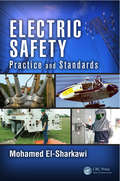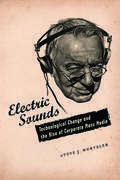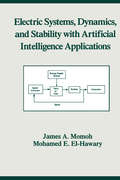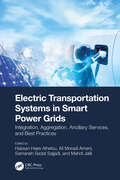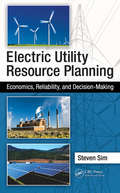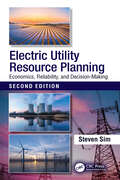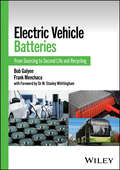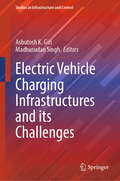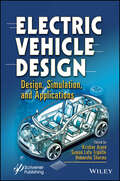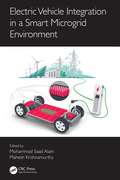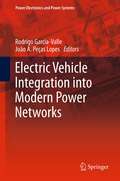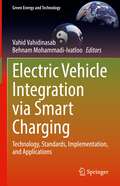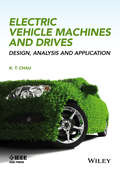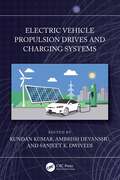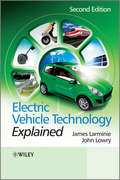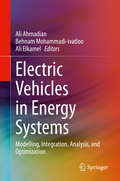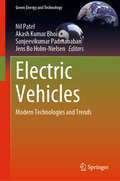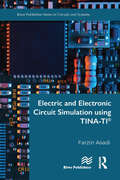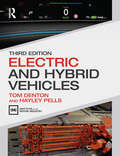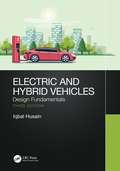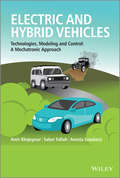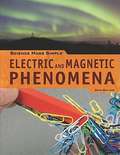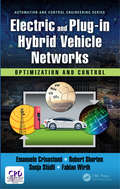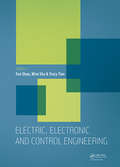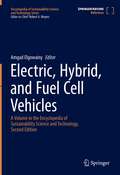- Table View
- List View
Electric Safety: Practice and Standards
by Mohamed A. El-SharkawiElectric power engineering education traditionally covers safety of the power equipment and systems. Little attention, if any, is given to the safety of people. When they reach professional status, most power engineers are not familiar with electric safety issues such as practices governing site works or grounding techniques of dwellings, hospitals
Electric Sounds: Technological Change and the Rise of Corporate Mass Media (Film and Culture Series)
by Steve WurtzlerElectric Sounds brings to vivid life an era when innovations in the production, recording, and transmission of sound revolutionized a number of different media, especially the radio, the phonograph, and the cinema. The 1920s and 1930s marked some of the most important developments in the history of the American mass media: the film industry's conversion to synchronous sound, the rise of radio networks and advertising-supported broadcasting, the establishment of a federal regulatory framework on which U.S. communications policy continues to be based, the development of several powerful media conglomerates, and the birth of a new acoustic commodity in which a single story, song, or other product was made available to consumers in multiple media forms and formats.But what role would this new media play in society? Celebrants saw an opportunity for educational and cultural uplift; critics feared the degradation of the standards of public taste. Some believed acoustic media would fulfill the promise of participatory democracy by better informing the public, while others saw an opportunity for manipulation. The innovations of this period prompted not only a restructuring and consolidation of corporate mass media interests and a shift in the conventions and patterns of media consumption but also a renegotiation of the social functions assigned to mass media forms. Steve J. Wurtzler's impeccably researched history adds a new dimension to the study of sound media, proving that the ultimate form technology takes is never predetermined. Rather, it is shaped by conflicting visions of technological possibility in economic, cultural, and political realms. Electric Sounds also illustrates the process through which technologies become media and the ways in which media are integrated into American life.
Electric Systems, Dynamics, and Stability with Artificial Intelligence Applications (Power Engineering #8)
by Mohamed E. El-Hawary James A. MomohThis work seeks to provide a solid foundation to the principles and practices of dynamics and stability assessment of large-scale power systems, focusing on the use of interconnected systems - and aiming to meet the requirements of today's competitive and deregulated environments. It contains easy-to-follow examples of fundamental concepts and algorithmic procedures.
Electric Transportation Systems in Smart Power Grids: Integration, Aggregation, Ancillary Services, and Best Practices
by Hassan Haes Alhelou Ali Moradi Amani Samaneh Sadat Sajjadi Mahdi JaliliThe leading countries around the globe, including Australia, have taken serious steps to decarbonize their energy and transportation sectors as part of their obligations for a suitable future with fewer emissions and a better environment. The decarbonization plans in different countries have resulted in changes such as increases in the penetration level of renewable energy sources and the introduction of electric vehicles as a target for future transportation systems. This is the point where mobility meets electricity and brings new challenges and opportunities, especially in the integration with modern power systems. The main impact would be on the demand-side and the distribution network. These impacts would be also reflected in the operation, control, security, and stability of transmission systems. This creates a new grid architecture characterized by a growing variability and uncertainties. Moreover, the growth in the share of renewable energy in the total energy market is one of the major causes of the increasing fluctuations in the balance between generation and consumption in the whole system. Therefore, the key challenge lies in developing new concepts to ensure the effective integration of distributed energy resources and electric transportation systems, including EVs, into existing and future market structures. Electric Transportation Systems in Smart Power Grids address how these issues—EVs, E-buses, and other smart appliances on the demand side—can be aggregated to form virtual power plants, which are considered an efficient solution to provide operational flexibility to the grid. The book also discusses how EV-based virtual power plants can also provide myriad services for distribution system operators, transmission system operators, and even local prosumers within the energy community. Features: Describes the services required to power systems from EVs and electric transportation sector Covers frequency control in modern power systems using aggregated EVs Discusses the integration and interaction between EVs and Smart grids Introduces electric vehicle aggregation methods for supporting power systems Highlights flexibility provided from electric transportation system to smart energy sector Discusses the high penetration level of renewable energy sources and EVs
Electric Utility Resource Planning: Economics, Reliability, and Decision-Making
by Steven SimMost people—including many legislators, regulators, and other decision makers in the electric utility industry—have misconceptions about how electric utilities really "work" and plan for the future. This lack of understanding can lead to poorly informed decisions and policies that directly affect the choices utilities must make. Using easy-to-understand text and examples, Electric Utility Resource Planning: Economics, Reliability, and Decision-Making clarifies how utilities operate their systems and prepare for the future. This explanation will show readers that both expected and counterintuitive results can occur (i.e., conservation might result in higher air emissions, or lowering costs could lead to higher electric rates). Taking readers step by step through this process, the book (in the following order): "Creates" a hypothetical utility Explains how and why a utility operates its system of generating units Discusses the planning methods that a utility would (or should) use Guides readers through each stage of a planning analysis for the hypothetical utility, examining various resource options (conservation, new power plants, and solar) In addition, the author introduces four Fundamental Principles of Resource Planning that should guide utilities. He also offers opinions on how certain trends in utility regulation and legislation can hinder utility planners’ efforts to identify and select the best resources for the utility’s customers. With this book, author Dr. Steven Sim applies his experience and insights from more than two decades of resource planning for Florida Power and Light (FPL). As one of the largest utilities in the United States, FPL has faced a multitude of resource planning challenges, and Dr. Sim has performed and supervised thousands of analyses designed to meet these obstacles. He has also served as an FPL witness in regulatory hearings on a wide variety of topics, ranging from the economic implications of nuclear, conservation, coal, gas, and other resource options, to the non-economic impacts (air emissions, fuel usage, system reliability, etc.) they present.
Electric Utility Resource Planning: Economics, Reliability, and Decision-Making
by Steven SimIn 2012, using easy-to-understand text and examples, the first edition of this book explained how electric utilities “work,” and how they plan (or should plan) for the future, by: "Creating" a hypothetical electric utility Explaining how (and why) this utility will operate its system of generating units Guiding readers through a planning analysis for the utility, examining various resource options (solar, new gas-fueled generation, and conservation) Introducing four Fundamental Principles of Resource Planning that should guide utilities as they plan for the future The first edition material, with significant updates, now appears as Part I of the second edition of this book. Part II of this book then presents six all-new chapters that address the challenges (and opportunities) of moving toward a zero-carbon future. Using the same hypothetical utility, with its new goal to utilize solar and batteries to serve 100% of its customers’ energy with zero carbon emissions by a future “target”year, Part II of this book addresses many subjects, including: The enormous amount of MW of new solar and batteries the utility will need to add Why certain characteristics of new solar and battery additions change as increasing amounts of these resources are added In the years prior to achieving its zero-carbon goal, how the hourly operation of the utility’s existing fossil-fueled generators, plus the new solar, will change (and why the stability of the transmission grid will be challenged) With this second edition, author Dr. Steven Sim again applies the experience and insights he gained from more than 30 years of resource planning for Florida Power & Light (FPL). As one of the largest electric utilities in the United States, FPL has faced a multitude of resource planning challenges, including how to get to zero carbon. During this time period, Dr. Sim performed and directed thousands of analyses designed to address these challenges. He also served as an expert witness in dozens of regulatory hearings, addressing both the economics of resource options and the non-economic impacts (air emissions, system reliability, fuel usage, etc.) associated with these options.
Electric Vehicle Batteries: From Sourcing to Second Life and Recycling
by Bob Galyen Frank MenchacaUnderstand the batteries that will power the sustainable transition from innovators who are making it happen The transition from fossil-fuel based energy sources to electricity is one of the most crucial technological milestones in the world today. The surge of electric vehicle production will require hundreds of millions of electric vehicle batteries, the creation of which have environmental impacts of their own. There is an urgent need for resources which analyze these impacts, their role in the life cycle of a battery, and the broader challenges and opportunities of this electric transition. Electric Vehicle Batteries: From Sourcing to Second Life and Recycling meets this need with a thorough, accessible overview of batteries: how they are made, used, and re-used. Balancing theory and practice, and with coverage of all relevant vehicle types, it’s a crucial resource for engineers, scientists, students, and instructors. Created by some of the leading experts in the mobility industry, Electric Vehicle Batteries is a decisive contribution to the fight for a sustainable future. In Electric Vehicle Batteries: From Sourcing to Second Life and Recycling, readers will find: A programmatic structure for creating new engineering practices and teams that support them A safety-first approach to handling volatile materials An authorial and editorial team with extensive experience in both engineering and management Electric Vehicle Batteries: From Sourcing to Second Life and Recycling is ideal for reskilling engineers, undergraduate students, and other new entrants into the rapidly expanding field of electric vehicle production.
Electric Vehicle Charging Infrastructures and its Challenges (Studies in Infrastructure and Control)
by Madhusudan Singh Ashutosh K. GiriThe book presents basic terminologies of charging infrastructures such as types, levels, and suitable power converters applications. Various energy storage technologies, such as lithium-ion batteries charging strategies and battery management system (BMS) and battery swapping, are discussed in the book. In this book, some guidelines by the Ministry of Power and Ministry of Housing (Government of India) are discussed which can help an individual to set up a charging infrastructure at their end. Also, the novel idea and concepts developed by the researchers/academia and practicing engineers working in the domain of the EV charging infrastructures are incorporated. The active and reactive power control strategy along with other parameters estimation and control are also included to make this book popular among the readers.
Electric Vehicle Design: Design, Simulation, and Applications
by Himanshu Sharma Suman Lata Tripathi Krishan AroraELECTRIC VEHICLE DESIGN This book will serve as a definitive guide to conceptual and practical knowledge about the design of hybrid electrical vehicles (HEV), battery electrical vehicles (BEV), fuel cell electrical vehicles (FCEV), plug-in hybrid electrical vehicles (PHEV), and efficient EV charging techniques with advanced tools and methodologies for students, engineers, and academics alike. This book deals with novel concepts related to fundamentals, design, and applications of conventional automobiles with internal combustion engines (ICEs), electric vehicles (EVs), hybrid electric vehicles (HEVs), and fuel cell vehicles (FCVs). It broadly covers vehicle performance, configuration, control strategy, design methodology, modeling, and simulation for different conventional and hybrid vehicles based on mathematical equations. Fundamental and practical examples of conventional electrical machines, advanced electrical machines, battery energy sources, on-board charging and off-board charging techniques, and optimization methods are presented here. This book can be useful for students, researchers, and practitioners interested in different problems and challenges associated with electric vehicles. Furthermore, in explaining the design methodology of each drive train, design examples are presented with simulation results.
Electric Vehicle Integration in a Smart Microgrid Environment
by Mohammad Saad Alam Mahesh KrishnamurthyElectric Vehicle Integration in a Smart Microgrid Environment The growing demand for energy in today’s world, especially in the Middle East and Southeast Asia, has been met with massive exploitation of fossil fuels, resulting in an increase in environmental pollutants. In order to mitigate the issues arising from conventional internal combustion engine-powered vehicles, there has been a considerable acceleration in the adoption of electric vehicles (EVs). Research has shown that the impact of fossil fuel use in transportation and surging demand in power owing to the growing EV charging infrastructure can potentially be minimalized by smart microgrids. As EVs find wider acceptance with major advancements in high efficiency drivetrain and vehicle design, it has become clear that there is a need for a system-level understanding of energy storage and management in a microgrid environment. Practical issues, such as fleet management, coordinated operation, repurposing of batteries, and environmental impact of recycling and disposal, need to be carefully studied in the context of an ageing grid infrastructure. This book explores such a perspective with contributions from leading experts on planning, analysis, optimization, and management of electrified transportation and the transportation infrastructure. The primary purpose of this book is to capture state-of-the-art development in smart microgrid management with EV integration and their applications. It also aims to identify potential research directions and technologies that will facilitate insight generation in various domains, from smart homes to smart cities, and within industry, business, and consumer applications. We expect the book to serve as a reference for a larger audience, including power system architects, practitioners, developers, new researchers, and graduate-level students, especially for emerging clean energy and transportation electrification sectors in the Middle East and Southeast Asia.
Electric Vehicle Integration into Modern Power Networks
by João A. Peças Lopes Rodrigo Garcia-ValleElectric Vehicle Integration into Modern Power Networks provides coverage of the challenges and opportunities posed by the progressive integration of electric drive vehicles. Starting with a thorough overview of the current electric vehicle and battery state-of-the-art, this work describes dynamic software tools to assess the impacts resulting from the electric vehicles deployment on the steady state and dynamic operation of electricity grids, identifies strategies to mitigate them and the possibility to support simultaneously large-scale integration of renewable energy sources. New business models and control management architectures, as well as the communication infrastructure required to integrate electric vehicles as active demand are presented. Finally, regulatory issues of integrating electric vehicles into modern power systems are addressed. Inspired by two courses held under the EES-UETP umbrella in 2010 and 2011, this contributed volume consists of nine chapters written by leading researchers and professionals from the industry as well as academia.
Electric Vehicle Integration via Smart Charging: Technology, Standards, Implementation, and Applications (Green Energy and Technology)
by Behnam Mohammadi-Ivatloo Vahid VahidinasabThis book brings together important new contributions covering electric vehicle smart charging (EVSC) from a multidisciplinary group of global experts, providing a comprehensive look at EVSC and its role in meeting long-term goals for decarbonization of electricity generation and transportation. This multidisciplinary reference presents practical aspects and approaches to the technology, along with evidence from its applications to real-world energy systems. Electric Vehicle Integration via Smart Charging is suitable for practitioners and industry stakeholders working on EVSC, as well as researchers and developers from different branches of engineering, energy, transportation, economic, and operation research fields.
Electric Vehicle Machines and Drives: Design, Analysis and Application (Wiley - IEEE)
by K. T. ChauA timely comprehensive reference consolidates the research and development of electric vehicle machines and drives for electric and hybrid propulsions• Focuses on electric vehicle machines and drives• Covers the major technologies in the area including fundamental concepts and applications• Emphasis the design criteria, performance analyses and application examples or potentials of various motor drives and machine systems • Accompanying website includes the simulation models and outcomes as supplementary material
Electric Vehicle Propulsion Drives and Charging Systems
by Kundan Kumar Ambrish Devanshu Sanjeet K. DwivediThis book covers the introduction, theory, development, and applications of hybrid and electric vehicles and their charging infrastructures. It also discusses the real applications of power converters and electric drives to give the readers a flavour of how to design propulsion drives and fast charging systems for electric vehicles. It further covers important topics such as static and dynamic wireless charging systems, battery management, and battery swapping systems for electric vehicles.This book: Presents comprehensively different types of electric vehicles and their powertrain architecture. Highlights modern optimization techniques such as genetic algorithms, simulated annealing, particle swarm optimization, and ant colony optimization. Discusses different charging methods such as wired and wireless for a variety of batteries including lead acid, lithium-ion, and vanadium redox. Covers grid-to-vehicle, vehicle-to-grid, and vehicle-to-vehicle bidirectional power flow analysis. Showcases power 2X technologies such as power-to-ammonia, power-to-chemicals, power-to-fuel, power-to-gas, and power-to-hydrogen. The text is primarily written for senior undergraduate and graduate students as well as academic researchers in the fields of electrical engineering, electronics, and communications engineering.
Electric Vehicle Technology Explained
by James Larminie John LowryFully updated throughout, Electric Vehicle Technology, Second Edition, is a complete guide to the principles, design and applications of electric vehicle technology. Including all the latest advances, it presents clear and comprehensive coverage of the major aspects of electric vehicle development and offers an engineering-based evaluation of electric motor scooters, cars, buses and trains.This new edition includes:important new chapters on types of electric vehicles, including pickup and linear motors, overall efficiencies and energy consumption, and power generation, particularly for zero carbon emissionsexpanded chapters updating the latest types of EV, types of batteries, battery technology and other rechargeable devices, fuel cells, hydrogen supply, controllers, EV modeling, ancillary system design, and EV and the environmentbrand new practical examples and case studies illustrating how electric vehicles can be used to substantially reduce carbon emissions and cut down reliance on fossil fuelsfuturistic concept models, electric and high-speed trains and developments in magnetic levitation and linear motorsan examination of EV efficiencies, energy consumption and sustainable power generation.MATLAB® examples can be found on the companion website www.wiley.com/go/electricvehicle2eExplaining the underpinning science and technology, this book is essential for practicing electrical, automotive, power, control and instrumentation engineers working in EV research and development. It is also a valuable reference for academics and students in automotive, mechanical, power and electrical engineering.
Electric Vehicles in Energy Systems: Modelling, Integration, Analysis, and Optimization
by Ali Elkamel Behnam Mohammadi-Ivatloo Ali AhmadianThis book discusses the technical, economic, and environmental aspects of electric vehicles and their impact on electrical grids and energy systems. The book is divided into three parts that include load modeling, integration and optimization, and environmental evaluation. Theoretical background and practical examples accompany each section and the authors include helpful tips and hints in the load modeling and optimization sections. This book is intended to be a useful tool for undergraduate and graduate students, researchers and engineers who are trying to solve power and engineering problems related electric vehicles.Provides optimization techniques and their applications for energy systems;Discusses the economic and environmental perspectives of electric vehicles;Contains the most comprehensive information about electric vehicles in a single source.
Electric Vehicles: Modern Technologies and Trends (Green Energy and Technology)
by Akash Kumar Bhoi Sanjeevikumar Padmanaban Nil Patel Jens Bo Holm-NielsenThis book focuses on the latest emerging technologies in electric vehicles (EV), and their economic and environmental impact. The topics covered include different types of EV such as hybrid electrical vehicle (HEV), battery electrical vehicle (BEV), fuel cell electrical vehicle (FCEV), plug-in hybrid electrical vehicle (PHEV). Theoretical background and practical examples of conventional electrical machines, advanced electrical machines, battery energy sources, on-board charging and off-board charging techniques, and optimization methods are presented here. This book can be useful for students, researchers and practitioners interested in different problems and challenges associated with electric vehicles.
Electric and Electronic Circuit Simulation using TINA-TI®
by Farzin AsadiA circuit simulator is a computer program that permits us to see circuit behavior, i.e. circuit voltages and currents, without making the circuit. Use of a circuit simulator is a cheap, efficient, and safe way to study the behavior of circuits. The Toolkit for Interactive Network Analysis (TINA®) is a powerful yet affordable SPICE based circuit simulation and PCB design software package for analyzing, designing, and real time testing of analog, digital, VHDL, MCU, and mixed electronic circuits and their PCB layouts. This software was created by DesignSoft. TINA-TI is a spinoff software program that was designed by Texas Instruments (TI®) in cooperation with DesignSoft which incorporates a library of pre-made TI components for the user to utilize in their designs. This book shows how a circuit can be analyzed in the TINA-TI® environment. Students of engineering (for instance, electrical, biomedical, mechatronics, and robotics to name a few), engineers who work in the industry, and anyone who wants to learn the art of circuit simulation with TINA-TI can benefit from this book.
Electric and Hybrid Vehicles
by Tom Denton Hayley PellsElectric and hybrid vehicles are now the present, not the future. This straightforward and highly illustrated full-colour textbook is endorsed by the Institute of the Motor Industry (IMI) and introduces the subject for further education and undergraduate students as well as technicians and workshop owners, with sections for drivers who are interested to know more. This new edition contains extensively updated content, especially on batteries, charging and the high-voltage pathway and includes all new case studies and new images, photos and flow charts throughout. It covers the different types of electric vehicle, costs and emissions and the charging infrastructure before moving on to explain how hybrid and electric vehicles work. A chapter on electrical technology introduces learners to subjects such as batteries, control systems and charging, which are then covered in more detail within their own chapters. The book also covers the maintenance and repair procedures of these vehicles, including diagnostics, servicing, repair and first-responder information. The book is particularly suitable for students studying towards IMI Level 1 Award in Hybrid Electric Vehicle Awareness, IMI Level 2 Award in Hybrid Electric Vehicle Operation and Maintenance, IMI Level 3 Award in Hybrid Electric Vehicle Repair and Replacement, IMI Level 4 Award in the Diagnosis, Testing and Repair of Electric/Hybrid Vehicles and Components, IMI accreditation, City & Guilds (C&G) and all other EV/hybrid courses.
Electric and Hybrid Vehicles: Design Fundamentals
by Iqbal HusainA thoroughly revised third edition of this widely praised, bestselling textbook presents a comprehensive systems-level perspective of electric and hybrid vehicles with emphasis on technical aspects, mathematical relationships and basic design guidelines. The emerging technologies of electric vehicles require the dedication of current and future engineers, so the target audience for the book is the young professionals and students in engineering eager to learn about the area. The book is concise and clear, its mathematics are kept to a necessary minimum and it contains a well-balanced set of contents of the complex technology. Engineers of multiple disciplines can either get a broader overview or explore in depth a particular aspect of electric or hybrid vehicles. Additions in the third edition include simulation-based design analysis of electric and hybrid vehicles and their powertrain components, particularly that of traction inverters, electric machines and motor drives. The technology trends to incorporate wide bandgap power electronics and reduced rare-earth permanent magnet electric machines in the powertrain components have been highlighted. Charging stations are a critical component for the electric vehicle infrastructure, and hence, a chapter on vehicle interactions with the power grid has been added. Autonomous driving is another emerging technology, and a chapter is included describing the autonomous driving system architecture and the hardware and software needs for such systems. The platform has been set in this book for system-level simulations to develop models using various softwares used in academia and industry, such as MATLAB®/Simulink, PLECS, PSIM, Motor-CAD and Altair Flux. Examples and simulation results are provided in this edition using these software tools. The third edition is a timely revision and contribution to the field of electric vehicles that has reached recently notable markets in a more and more environmentally sensitive world.
Electric and Hybrid Vehicles: Technologies, Modeling and Control - A Mechatronic Approach (Wiley Desktop Editions Ser.)
by Amir Khajepour Avesta Goodarzi M. Saber FallahAn advanced level introductory book covering fundamental aspects, design and dynamics of electric and hybrid electric vehicles There is significant demand for an understanding of the fundamentals, technologies, and design of electric and hybrid electric vehicles and their components from researchers, engineers, and graduate students. Although there is a good body of work in the literature, there is still a great need for electric and hybrid vehicle teaching materials. Electric and Hybrid Vehicles: Technologies, Modeling and Control – A Mechatronic Approach is based on the authors’ current research in vehicle systems and will include chapters on vehicle propulsion systems, the fundamentals of vehicle dynamics, EV and HEV technologies, chassis systems, steering control systems, and state, parameter and force estimations. The book is highly illustrated, and examples will be given throughout the book based on real applications and challenges in the automotive industry. Designed to help a new generation of engineers needing to master the principles of and further advances in hybrid vehicle technology Includes examples of real applications and challenges in the automotive industry with problems and solutions Takes a mechatronics approach to the study of electric and hybrid electric vehicles, appealing to mechanical and electrical engineering interests Responds to the increase in demand of universities offering courses in newer electric vehicle technologies
Electric and Magnetic Phenomena (Science Made Simple)
by Dean GalianoThis book introduces the discovery that electric and magnetic phenomena are a result of positive and negative charges interacting with each other; researchers were able to isolate the negatively charged electron.
Electric and Plug-in Hybrid Vehicle Networks: Optimization and Control (Automation and Control Engineering)
by Emanuele Crisostomi Robert Shorten Sonja Stüdli Fabian WirthThis book explores the behavior of networks of electric and hybrid vehicles. The topics that are covered include: energy management issues for aggregates of plug-in vehicles; the design of sharing systems to support electro-mobility; context awareness in the operation of electric and hybrid vehicles, and the role that this plays in a Smart City context; and tools to test and design massively large-scale networks of such vehicles. The book also introduces new and interesting control problems that are becoming prevalent in the EV-PHEV's context, as well as identifying some open questions. A particular focus of the book is on the opportunities afforded by networked actuation possibilities in electric and hybrid vehicles, and the role that such actuation may play in air-quality and emissions management.
Electric, Electronic and Control Engineering: Proceedings of the 2015 International Conference on Electric, Electronic and Control Engineering (ICEECE 2015), Phuket Island, Thailand, 5-6 March 2015
by Fun Shao Wise Shu Tracy TianElectric, Electronic and Control Engineering contains the contributions presented at the 2015 International Conference on Electric, Electronic and Control Engineering (ICEECE 2015, Phuket Island, Thailand, 5-6 March 2015). The book is divided into four main topics: - Electric and Electronic Engineering - Mechanic and Control Engineering - Informati
Electric, Hybrid, and Fuel Cell Vehicles (Encyclopedia of Sustainability Science and Technology Series)
by Amgad ElgowainyThis volume of "Encyclopedia of Sustainability Science and Technology, Second Edition," covers the electrification of vehicles, which is key to a sustainable future of transportation in both light-duty and heavy-duty vehicle sectors to address global concerns of climate change, air pollutant emissions, energy efficiency and energy security. Vehicle electrification includes several existing and emerging technologies and powertrain architectures such as conventional hybrid electric vehicles (HEVs), plug-in hybrids with various electric driving range, short- and long-range battery electric vehicles, as well as hydrogen fuel cell electric vehicles (FCEVs). Electrification will be key to connected autonomous vehicles, which are perceived to improve mobility, increase safety, reduce energy consumption and infrastructure costs, improve productivity, decrease traffic congestion and increase customer satisfaction. While electrification of vehicle technologies is relatively mature, technology improvement and economies of scale are needed to compete against incumbent technologies and to realize their benefits in the marketplace. Significant infrastructure development is needed in the case of hydrogen fuel cell vehicles and to a lesser extent for plug-in electric vehicles.Vehicle efficiency improvement is sought through a combination of several approaches, including weight reduction, engine downsizing, increased engine compression ratio with high octane fuels, and the use of compression ignition engines with low octane fuels. Liquid hydrocarbon fuels are needed in applications where high storage energy density is required such as long-haul class-8 combination heavy-duty trucks. Shared mobility is another emerging concept that enables access to transportation services on an as-needed basis. This approach can enhance accessibility to transportation, decrease number of vehicles on the road, reduce energy use and impact on the environment, reduce cost of transportation and the need for parking, and reduce transportation time between origin and destination. In all, the reader will receive a comprehensive introduction to electric vehicles and technology trends, including energy storage, in light-, medium-, and heavy-duty sectors, as well as the infrastructure development that will be required to realize these benefits for society.
